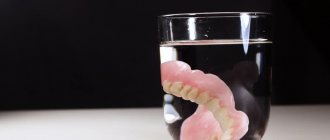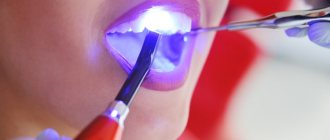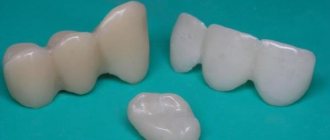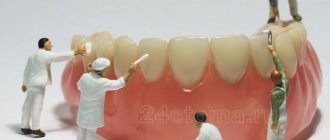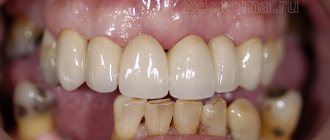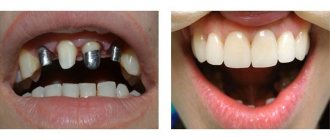Today, metal-ceramics is considered one of the most popular materials for prosthetics in dentistry. Its main advantages are high strength and durability, decent aesthetics and affordable cost. However, in order for prosthetics to be truly durable and reliable, the patient should know how to properly care for metal-ceramic teeth and carry out such care regularly.
Crown care
Artificial teeth are not prone to decay and are not susceptible to carious damage. However, if there is no care for teeth with crowns, plaque forms on the surface and an unpleasant odor appears. These factors contribute to the formation of tartar, which, in turn, provokes serious dental problems.
Caring for ceramic crowns is simple; usually the whole procedure comes down to daily preventative cleaning of teeth and installed structures. It is not necessary to go to a dental clinic for this.
Material strength
In most cases, metal-ceramic dentures are used to replace teeth that perform an active chewing function. And it doesn’t matter whether it’s a separate crown or a bridge.
Metal-ceramic dentures are very durable and can cope with any food, even hard ones. But don’t forget that this is still a prosthesis, which means you need to be careful with it and not conduct experiments, such as cracking nuts.
Dentists note that the strength of such structures is high, but not infinite.
How to care for crowns
If we consider the situation as a whole, proper care of crowns is no different from the prevention of all dental diseases. However, professionals recommend following the following rules:
- Hygienic cleaning of teeth and installed structures twice a day. To do this, it is better to use pastes with a minimum abrasiveness coefficient so as not to damage the enamel and soft tissues.
- Carefully remove food debris from the interdental space. An irrigator copes with this task perfectly.
- Rinse your mouth after every meal. To do this, you can use special compounds or just warm water.
- Watch your diet. If crowns are installed, it is better to avoid eating nuts, crackers, etc.
- Control food temperature. Too hot tea or ice-cold lemonade can cause cracking of the relatively fragile cermets.
Dentists recommend massage for crown care. Such structures create increased pressure on the gums, so it is important to stimulate blood circulation in the soft tissues. The massage is performed with smooth, circular movements along and counterclockwise.
Hygiene features
Products made of metal ceramics do not require any special care, as they are durable, their surface is so smooth that they do not accumulate plaque. Care for metal-ceramic teeth must be organized in the same way as for natural teeth, the main thing is to do it regularly and efficiently.
You can clean metal-ceramic teeth with a regular brush.
Metal ceramics do not require a special diet, but you should not test its strength (opening bottles with your teeth, gnawing bones, etc.). Due to such experiments, the ceramic layer may chip, after which the prosthesis will have to be repaired or replaced.
It is also necessary to remember that there is a living tooth under the crown. It is important to prevent food from getting under the crown. Yes, this is possible even with modern technologies that make it possible to produce dentures that fit perfectly to the ground tooth and gum.
Expert opinion. Dentist at the Doctor-RAF clinic. : “The gums are very pliable, so when chewing food, pieces of it can easily push away the mucous membrane and get stuck between the gum and the denture. Over time, inflammation, swelling, and soreness will occur. For this reason, a small distance is specially left between the gum and the crown - a rinsing space. This gap allows the usual rinsing to clear out food that is stuck there.”
Seeing a doctor
You need to make an appointment with a dentist if the following problems occur:
- The installed structure has lost stability;
- There is an unpleasant odor from the mouth;
- An inflammatory process is observed on the gums, pain is felt;
- The crown is installed incorrectly, causes discomfort to the person, and interferes with other teeth;
- The prosthesis fell out.
In addition, you need to visit the clinic for professional preventive cleaning and crown replacement. The service life of such structures varies between 2-15 years, depending on the material of manufacture and compliance with operating rules. Even if the service life of the crown has not expired, it is better to replace it if the color changes or cracks appear. Do not self-medicate, it is better to consult a specialist!
When can metal ceramics be installed?
Metal-ceramic dental crowns will be an excellent alternative to other dentures in the case of the absence of one tooth in any part of the dentition, although, given the availability today of more aesthetic dentures, metal-ceramics are preferred to be installed in the chewing area of the upper or lower jaws. Dental crowns made of metal-ceramics are often used to restore several lost teeth in a row - this design is called a “metal-ceramic bridge.” Typically, a metal-ceramic bridge replaces up to four missing teeth.
The benefits of an irrigator when caring for zirconium crowns
The irrigator is ideal for caring for zirconium crowns and dental structures. The operating principle of the irrigator is based on a directed pulse of water with adjustable intensity. Such equipment massages the gums and effectively cleans the interdental space. Unlike dental floss, it is impossible to damage soft tissues with an irrigator; there is absolutely no discomfort during such treatment.
You can purchase the irrigator in a stationary or portable version. The second option is slightly inferior in terms of water capacity, but you can take the device with you and care for your oral cavity while traveling.
Author of the article
What types of dentures are there and what are they made of?
Today, the types of dentures, as well as the materials from which they are made, are varied. If the patient is missing one tooth and its root has not been preserved, then it would be best to install an implant and a dental crown on it. If several teeth are missing in the oral cavity, the situation will be saved by installing a bridge (possibly also on implants as the most reliable design). In the case of complete edentia, we will talk about restoring teeth using a complete denture, be it a fixed denture on implants or a complete removable denture.
We should not forget that the material from which dental crowns are made is no less diverse than the structures on which these crowns are fixed. In this case, the beauty and strength of the crown part of the tooth will depend on the material .
Considering the high degree of desired aesthetics, we can safely say that metal dental crowns are hopelessly outdated, just like crowns made of precious metals (white beautiful teeth have long replaced shiny gold teeth). The leading positions are occupied by zirconium dioxide crowns and all-ceramic dental crowns (metal-free ceramic crowns). But along with them, thanks to decent aesthetics and reasonable prices, metal-ceramic crowns remain quite in demand, which we will talk about in more detail.
Special dental floss
To care for bridges, only threads labeled “super floss” are used and only if the dentist has given permission. How to clean bridges with floss? In “superflosses,” the thread is rigid on one edge; it is on this side that the thread is inserted between the outer crown of the bridge and the natural tooth. Then the thread is pulled to its soft thickened part, which is used for cleansing with gentle movements. Then the floss, again with the hard side, can be additionally inserted into the subprosthetic space (a small gap between the gum and the “empty” crowns of the bridge, if any) and passed with the soft “middle” to the opposite supporting tooth. Pull the superfloss out from under the prosthesis, holding it by the hard edge.
Cleaning
In addition to following all of the above recommendations, you need to be able to clean cermet teeth properly. For this procedure, only a soft toothbrush is used. All movements are carried out strictly in a vertical direction from the gum tissue to the edge of the crown.
Metal-ceramic structures do not require special care.
They are durable, so brushes of any hardness are suitable. And when choosing a paste, they prefer products to strengthen the gums. The only limitation is to avoid excessively hard food, as this can cause the ceramic to chip and expose the dark iron frame.
Dentist
Novikova Olga Alexandrovna
8 years of experience
No less important attention should be paid to the space between the teeth. It is better to use a paste that contains propolis or herbal preparations. It is necessary to clean the dental surface not only after waking up and before going to bed at night, but also after each meal.
To clean the interdental space as best as possible, dentists recommend not to ignore the use of dental floss, or floss. Upon completion of the procedure, the oral cavity must be rinsed with special solutions (rinses).
If metal-ceramic bridges have been installed, then the flushing channels located between the gums and artificial crowns must be cleaned with special care. If you do not pay due attention to this, then food debris begins to accumulate in the cavity, which subsequently leads to rotting and the appearance of an unpleasant odor.
To clean such spaces, special small brushes (tooth brushes) are used. When plaque forms on the surface, special products are used that the dentist may recommend.
Toothpaste for orthopedic structures
What is the best way to clean dental bridges? Many patients use children's pastes or tooth powders. But the former cannot always cope with plaque on the crowns, and the latter scratch the ceramic lining of artificial teeth. Therefore, it is better to use specialized products - they are suitable both for cleaning fixed prostheses (crowns, bridges, veneers) and for those who wear braces. Let's look at the most popular pastes:
- ROCS PRO Brackets & Ortho: special proteolytic components and granules in the composition help break down plaque on bridges and teeth, even in hard-to-reach areas. Does not contain fluoride (which can be harmful if swallowed), but instead contains safe and bioavailable remineralizing ingredients that strengthen enamel,
- PresiDENT Profi Ortho Braces: contains xylitol and natural ingredients - aloe and licorice root extracts, pineapple, papain. They contribute to thorough and gentle removal of plaque, long-term preservation of freshness,
- Dentaid Vitis Orthodontic: contains antibacterial ingredients and plant extracts, reduces the risk of inflammation and remineralizes enamel,
- Pierrot Orthodontic Natural Freshness: prevents the development of caries due to phosphates and plant extracts, also slows down the formation of plaque on teeth and crowns,
- Dental Pro Ortho&Brackets: with antibacterial effect, hyaluronic acid for gum restoration,
- Corega 2 in 1: does not contain abrasive particles, has a mint taste, and the fluoride content at a dosage of 1450 ppm helps strengthen your own teeth,
- “Professor Persin” for sensitive teeth: contains sodium fluoride, xylitol, aloe extract, therefore it simultaneously protects against caries and plaque formation, moisturizes the mucous membranes, and prevents the formation of foci of infection.
Read on the topic: what kind of toothpaste should be for dentures, and which one to choose.
A dental bridge fell out: what to do?
Dental bridges, as well as dental crowns, as well as other orthopedic structures, have a service life, after which they must be replaced. Modern materials and manufacturing and installation technologies make the shelf life of orthopedic structures quite long, but this does not negate the mandatory removal of a dental bridge whose shelf life has expired. Unfortunately, many patients, if not the majority, ignore the need to remove the bridge and replace it with a new one until the problem becomes a rib, that is, until the dental bridge falls off.
A timely, regular visit to the dentist will help to avoid such a problem, who will be able to detect that the dental bridge has become loose or has begun to collapse, before the patient feels it himself. The fact is that the shelf life of a bridge is limited not so much by the properties of the manufacturing material itself (with proper care it is practically not subject to erosion), but by the fragility of the composite materials with which the lateral crowns of the bridge are attached to the supporting teeth, as well as the danger of development under these crowns secondary caries, which is aggravated by the fact that the supporting teeth are most often “dead”, pulpless, which reduces their resistance to carious lesions. So how is a dental bridge removed? Considering that after removing the bridge, a new one needs to be installed in its place (in rare cases, it is possible to install the same structure if it is not damaged, but with fresh cement), it is very important not to damage the supporting teeth in order to avoid even further grinding of them. For this purpose, special ultrasonic devices are used, which cause the cement between the crown and the tooth to crumble, after which the bridge is removed.
If the dental bridge breaks and falls off, you must immediately consult a doctor, since the ground supporting teeth should not be open, this will lead to their damage, in addition, the bridge could become detached traumatically, and only a specialist can notice and correct this.
Very often on various forums you can come across the question: “What to do if the dental bridge is wobbly?” The answer is simple: consult a doctor immediately. Perhaps the installation technology was violated or the design was not accurately adjusted to the ground abutment teeth. If the dental bridge begins to sway several years after installation, this may indicate the presence of the above-mentioned secondary caries or partial destruction of the cement between the crown and the tooth tissues.
It is also necessary to consult a specialist if you experience toothache under the bridge. This is another sign of secondary caries. If the gums hurt at the point of contact with the central part of the bridge, perhaps the structure was set too deeply, which caused rubbing of the soft tissues by the edge of the bridge, and this in turn can lead to the formation of bruises and bedsores, and in advanced cases, to an inflammatory process.
If chips or microcracks have formed on the artificial enamel of a dental bridge (in the case of ceramic and metal-ceramic structures), it is most often possible to repair dental bridges with composite materials directly in the patient’s oral cavity. In some cases, it is also possible to repair structures made of plastic and metal-plastic. WARNING: If you swallow a dental bridge or a fragment of it, go to a clinic or emergency room. An ultrasound examination of the gastrointestinal tract may be required, since the sharp edges of the chips can damage the mucous membranes of the stomach, esophagus and intestines.
Reasons for the development of pathology
According to dentists, the problem may be due to a number of reasons:
- Low quality dental products. The design does not fit tightly in the area of the tooth neck, as a result of which food and bacteria get under it.
- Insufficient oral hygiene. Pieces of food stuck in the interdental space begin to rot, resulting in a carious process.
At an advanced stage of caries, a space is formed next to or under the denture, into which food particles fall and decay begins. This contributes to the appearance of unpleasant sensations from the mouth.
